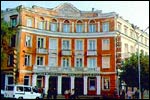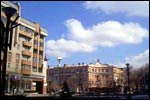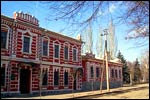HISTORY OF KRIVOY ROG
There are a lot of legends about Krivoy Rog. One of them says that the city was established by a Cossack named Rog. But everybody was used to call him "Krivoy Rog" because he had an eye put out by sabre in a cruel battle with Tatar invaders. When going on a journey, he took a lot of salt with him and gave it to the people as he travelled. After journeying for some distance, he decided to settle down at the place where the two rivers (the Ingultsa and the Saksagan) converge. A lot of people came to his settlement: some came to ask for salt, some stayed for a night after a long trip, some came to listen his stories about the war and some came to ask for advice.
As a result, more settlements appeared around Krivoy Rog. The Cossack Rog died when he was very old and the settlement kept on bearing his name - Krivoy Rog.
 The town began to grow really rapidly only when iron ore reserves were found by the Ukrainian archaeologist Alexander Pol at the end of the 19th century. The first steel manufacturer was the Gdantsev Mining Equipment Factory. Krivoy Rog grew up very fast. The settlements, at first separate, were joined into one big settlement but the old names were preserved (Gdantsevka, Dekanka, Karnavatka, Sukhaya Balka, Chervonaya Balka, etc.).
The town began to grow really rapidly only when iron ore reserves were found by the Ukrainian archaeologist Alexander Pol at the end of the 19th century. The first steel manufacturer was the Gdantsev Mining Equipment Factory. Krivoy Rog grew up very fast. The settlements, at first separate, were joined into one big settlement but the old names were preserved (Gdantsevka, Dekanka, Karnavatka, Sukhaya Balka, Chervonaya Balka, etc.).
 During World War I, Krivoy Rog was occupied by the troops of Kaiser Wilhelm. The clandestine struggle was active in the town. The town survived through revolution and civil war. After a coup d'etat, the power passed on to the people, soldiers and deputies councils. The main cathedral was destroyed. This destruction occurred in the cathedral square of the town.
During World War I, Krivoy Rog was occupied by the troops of Kaiser Wilhelm. The clandestine struggle was active in the town. The town survived through revolution and civil war. After a coup d'etat, the power passed on to the people, soldiers and deputies councils. The main cathedral was destroyed. This destruction occurred in the cathedral square of the town.
 The iron content in iron ore from Krivoy Rog is very high. In 1932, the construction of Krivoy Rog Iron and Steel Works began. The living district Sotsgorod (Socialistic Town) was erected along with the Works. The first town tram was laid out and built also around that time. On August 5, 1936, the first blast furnace "Komsomolka" gave the first cast iron (the blast furnace is still presently working). On September 11, 1941, Krivoy Rog was occupied by Hitler's troops. This occupation lasted until February 22, 1944. During this time, the Germans did not export iron ore, cast iron or steel from Krivoy Rog.
The iron content in iron ore from Krivoy Rog is very high. In 1932, the construction of Krivoy Rog Iron and Steel Works began. The living district Sotsgorod (Socialistic Town) was erected along with the Works. The first town tram was laid out and built also around that time. On August 5, 1936, the first blast furnace "Komsomolka" gave the first cast iron (the blast furnace is still presently working). On September 11, 1941, Krivoy Rog was occupied by Hitler's troops. This occupation lasted until February 22, 1944. During this time, the Germans did not export iron ore, cast iron or steel from Krivoy Rog.
 Today there are approximately 1 million people in Krivoy Rog, 7 districts, 4 iron-enriching factories and multiple other types of enterprise.
Today there are approximately 1 million people in Krivoy Rog, 7 districts, 4 iron-enriching factories and multiple other types of enterprise.